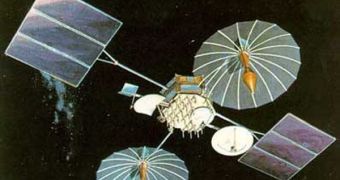Officials at the American space agency announce that the Tracking and Data Relay Satellite 4 (TDRS-4) has been retired from active service after more than 23 years of operations in Earth's orbit. The mission was originally planned for a lifespan of only 10 years.
The communications spacecraft was launched aboard the space shuttle Discovery during the STS-29R mission, from the Kennedy Space Center (KSC), in Florida. Takeoff occurred on March 13, 1989, at 14:57 GMT. The spacecraft itself weighs around 3,180 kilograms (7,000 pounds).
TDRS-4 completed all end-of-mission deorbit and decommissioning activities successfully. It is currently located in the same geosynchronous orbit that it occupied since launch. The spacecraft is perched some 22,000 miles (nearly 36,000 kilometers) high, above the Atlantic Ocean.
Just before the vehicle was retired from active duty, NASA mission controllers ordered it to move higher up, in order to clear some space in the congested GEO. This orbit is heavily used by satellites, so the risk of collision is high.
According to experts, this is the second TDRS spacecraft to be retired from the fleet. The entire constellation is now left with 7 operating satellites, which make up the NASA Space Network (SN).
“The network supports a varied number of missions, including the International Space Station, Hubble Space Telescope, launch vehicles, and a variety of other science missions. The SN also provided primary communication support to the Space Shuttle Project,” a NASA press release says.
TDRS-4 had four Nickel-Cadmium (24-cell) batteries when it launched. The loss of one such battery is the main reason why the space agency decided to pull the plug on the mission. All batteries were disconnected, and the Radio Frequency Transmitters and receivers were shut down.
This was done in order to ensure that no radio interference would occur between this satellite and other spacecraft flying close to it. The vehicle is now completely and permanently passive, experts say.
“The Space Network spacecraft engineering and operations teams worked together very effectively to execute a practically flawless decommissioning of an incredible satellite. TDRS-4 made great and important contributions to NASA's human spaceflight and science missions,” Mike Rackley says.
The expert holds an appointment as the deputy project manager for the SN, and is based at the NASA Goddard Space Flight Center (GSFC), in Greenbelt, Maryland.

 14 DAY TRIAL //
14 DAY TRIAL //